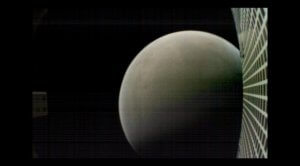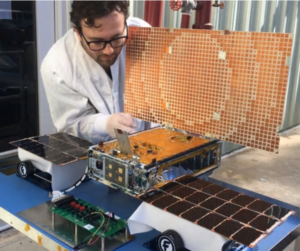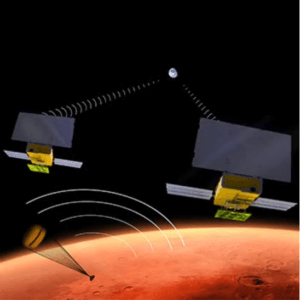Space Solar Power Incremental Demonstration and Research Project (SSPIDR)
MMA is excited to be involved in developing this revolutionary new technology alongside our AFRL partners.
MMA Design on STR’s payload team for DARPA’s Blackjack Program
Congratulations to Systems & Technology Research (STR) for having been awarded a key role on this exciting demonstration! MMA is thrilled to be on STR’s payload team for this DARPA mission. To learn more about the Blackjack program, click here to read the full press release from DARPA.
In the News: MMA’s Lunar FlashLight HaWK
MMA is proud and excited to have provided critical space power to this NASA JPL technology demonstration mission which aims to look for water ice inside the moon’s darkest, coldest craters using lasers. Read more at Space Newsfeed.
FalconSAT-7 Finally Earns its Wings!
FalconSat-7 is a technology demonstration mission to test a solar space telescope incorporating a membrane photon sieve deployed from a 3U CubeSat to image the sun. It took flight on early Tuesday morning, June 25, on a SpaceX Falcon Heavy rocket, along with over 2 dozen other small satellites.
FalconSAT-7 was a engineering collaboration between the United States Air Force Academy (USAFA), the Air Force Research Laboratory (AFRL) and MMA. USAFA designed the photon sieve and spacecraft, while MMA designed, built and integrated the deployment mechanism which controls the accuracy of the photon sieve’s position and surface.
New missions, based on this technology, will make it possible to significantly reduce cost, with apertures (and hence resolutions) previously thought unobtainable. Due to its high packing ratios, this mission will prove that it’s possible to construct extremely compact satellites that are simple to manufacture and launch in large numbers with short lead times.
Another MMA HaWK Takes Flight!
Another MMA HaWK Solar Array launched at 2 am Eastern on May 5th from New Zealand on a Rocket Lab Electron rocket. The Space Plug and Play Architecture Research CubeSat-1 (SPARC-1), a six-unit cubesat sponsored by the Air Force Research Laboratory in cooperation with the Swedish military, was one of three satellites hitching a ride yesterday. MMA’s HaWKs will provide critical space power to the SPARC-1 mission which is a technology demonstration aiming to test modular spacecraft avionics.
MarCO Mission’s twin CubeSats rule the headlines!
MarCO’s tiny, twin CubeSats have captured the attention of the entire world!
Their successful voyage to Mars — and the demonstration that smaller, less exquisite assets like these backpack-sized CubeSats can provide powerful support to missions, such as the data/communications relay proven with MarCOs A and B when the InSight Lander arrived at Mars on Monday, November 26, 2018 — is a giant leap forward for CubeSat technology, and a source of pride and excitement for the entire SmallSat community!
MMA is thrilled to have been involved in this milestone technology demonstration by providing space power to the MarCO CubeSats with our first, dual-axis deployment HaWK solar arrays. From all reports, our HaWKs surpassed power estimates on their interplanetary mission to the red planet, and now, BEYOND!
Learn more about this historic mission, and MarCO’s role in it, around the web:
https://spacenews.com/marco-success-vindicates-use-of-cubesats-on-deep-space-missions/
https://www.latimes.com/science/sciencenow/la-sci-sn-mars-insight-marcos-20181126-story.html
https://www.nasa.gov/feature/jpl/nasa-hears-marco-cubesats-loud-and-clear-from-mars
https://www.nytimes.com/2019/03/18/science/cubesats-marco-mars.html
We’re just going to leave this right here…

A beautiful image of Mars from a MarCO CubeSat
JPL’s ASTERIA wins SmallSat Mission of the Year!
Congratulations to the ASTERIA mission for winning SmallSat Mission of the Year at the 2018 SmallSat Conference in Logan, Utah! MMA is proud and excited to have our HaWK Solar Arrays flying on this mission currently. For more about our ASTERIA HaWKs, please click here.
MarCO HaWKs Headed to Mars!
The Insight mission launched on schedule from Vandenburg Air force base in California on May 5 at 4:45 am. When NASA’s Insight mission launched, it was accompanied by two identical, backpack-size satellites collectively called Mars Cube One, or MarCO.
The power system on the MarCO cubesats includes MMA’s HaWK Solar Arrays, and from all reports, the HaWKs deployed successfully and the power system is working flawlessly!
MarCO-A and MarCO-B (aka Wall-E and Eva) are officially the smallest satellites ever sent past the moon on an interplanetary journey! The MarCO cubesat pair were deployed from the launch vehicle separately from the Insight Lander, and while they are carrying their own communications and navigation experiments as they fly independently to the Red Planet, their job is to radio back data about InSight while it enters the atmosphere and descends to the planet’s surface. By proving that CubeSats are a viable technology for interplanetary missions, and feasible on a short development timeline, this technology demonstration could lead to many other applications to explore and study our solar system.
Check out this awesome video which shows the MarCO cubesats in action.
MMA is proud and thrilled to be part of this exciting mission!
The team celebrated on May 4 in anticipation of the launch with MarCO-ritas to commemorate this exciting milestone.
MarCO Mission HaWKs poised for launch!
MMA’s HaWK Solar Arrays are ready to provide essential power to MarCO cubesats, which are now integrated on the Atlas V vehicle at Vandenburg AFB, and ready for their launch window on May 5th.
MarCO is the first cubesat mission into deep space!
MarCO is sharing the launch with the InSight Mission and will fly separately to Mars. The Atlas V rocket that will loft InSight beyond Earth will also launch a separate NASA technology demonstration: two mini-spacecraft called Mars Cube One, or MarCO. These briefcase-sized CubeSats will fly on their own path to Mars behind InSight. Their goal is to test new miniaturized deep space communication equipment and, if the MarCOs make it to Mars, may relay back InSight data as it enters the Martian atmosphere and lands. This will be a first test of miniaturized CubeSat technology at another planet, which researchers hope can offer new capabilities to future missions.

MarCO cubesat
Find out more about this exciting mission, and see our HaWK solar arrays in action in this video from JPL.

If successful, the MarCOs could represent a new kind of communication capability to Earth!
How can we help your mission?
Contact us to discuss how MMA can help take your mission to the next level.
Contact Us








